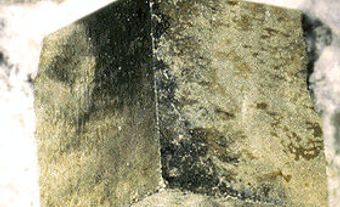Metallurgy is the art, science and technology of turning metals and alloys (i.e., materials consisting of two or more metals) into forms suitable for practical use. Some metals are found in their "native" or free elemental form (e.g., gold, silver, copper), and a limited number can be produced from sea water, notably magnesium. However, most metals are extracted from naturally occurring mineral compounds found at or near the earth's surface. In Canada, most non-ferrous metals (i.e., metals other than iron and steel) are produced from sulphide ores. There are three steps in extracting metals from their ores: mineral processing, chemical extraction and refining.
Mineral Processing
Mineral processing involves the chemical and physical treatment of the ore to upgrade the valuable mineral component before the metal-extraction stage. This processing eliminates as much of the waste portion as possible. Two principal steps are involved: comminution and separation.
Comminution
Comminution is the liberation of the desired mineral (e.g., nickel sulphide, copper sulphide) from the waste (gangue) by crushing and grinding. The ore is crushed by jaw crushers and cone crushers. The crushed ore is then ground in ball mills and rod mills to particle sizes less than 75 micrometres (μm). Grinding is usually carried out in water to minimize dust. The degree of grinding depends on the size and distribution of the valuable mineral in the ore. Many of the sulphide deposits in Canada require grinding to a product size less than 30 μm.
Separation
Separation of the desired mineral from the waste produces an enriched portion (i.e., concentrate) and a discard portion (i.e., tailings). Separation is performed by taking advantage of differences in the physical and chemical properties of the minerals, such as density, radioactivity, magnetism, electrical conductivity and surface reactivity. The most commonly used property, surface reactivity, has proven to be very selective, particularly for sulphide ores. The separation process based on this property is called flotation. In flotation, air is bubbled through the pulp (i.e., a mixture of finely ground ore and water) in a tank which is agitated vigorously to break the air into fine bubbles. The valuable mineral is picked up by the bubble and floated to the surface to form a stable froth, which is skimmed off. The flotation column is a Canadian invention and a major advance in 1980s flotation technology; it is typically 13 m high by 1–2 m in diameter.
The concentrates produced through mineral processing are drastically reduced in bulk and weight compared to the original ore. For example, 100 kg of copper ore containing as little as 1 per cent metal in the form of a sulphide can be upgraded to 4 kg of concentrate containing 25 per cent copper, a 96 per cent reduction in the weight of the initial ore.
Chemical Extraction
Unlike metal oxides (i.e., chemical compounds containing metal and oxygen), metal sulphides cannot be directly reduced to the metallic state. Extraction processes are often referred to as pyrometallurgical (i.e., high-temperature processes such as smelting, roasting and distilling, and involving furnaces) or hydrometallurgical (i.e., aqueous-solvent processes, usually operating near room temperature). Most metal-extraction processes use both high temperatures and aqueous solution treatments.
Sulphide Ores: Examples
Copper
In the case of copper, the principal mineral in the concentrate is chalcopyrite (CuFeS2). The traditional process for producing copper from this concentrate involved roasting, smelting, converting and refining. Roasting is the heating of the sulphide concentrates in air to temperatures of about 600-700°C to partially oxidize the iron sulphides to iron oxides and sulphur dioxide gas. The solid products of the roaster together with a flux (i.e., a substance used to promote fusion, in this case, silica) are then melted in a furnace (i.e., smelting) to separate and remove the oxide components as slag (i.e., waste) and the enriched copper-iron sulphides as matte (i.e., an impure product).
The liquid matte is transferred to a converter where the remaining iron and sulphur are removed by air blown through the matte. The resulting product is "blister" copper of more than 98 per cent purity. The impurities are present in the concentrate and remain in the copper during processing. Some of these impurities (e.g., zinc, tin, iron and sulphur) may be removed by a fire-refining step, in which air is blown into the molten copper to oxidize the impurities selectively to form a slag or oxide gas. The slag is then skimmed off and the copper is covered with charcoal to prevent further oxidation. At this stage the copper contains approximately 1 per cent oxygen.
Traditionally, most of this oxygen was removed by inserting and agitating a freshly cut tree trunk below the copper surface. Today, natural gas is usually used to reduce the oxygen content to about 0.13 per cent. This grade of copper, referred to as "tough pitch" copper, is sold to manufacturers. Sometimes precious metals are present in the copper in very small amounts. These cannot be removed by fire refining and the copper must undergo an additional refining process, called electrolytic refining.
In electrolytic refining, fire-refined copper is cast in the form of a large block, which acts as an anode (i.e., positive electrode). The block is placed into a copper-sulphate solution (i.e., an electrolyte, a solution in which electrical current is carried by ions) together with a thin sheet of high-purity copper, which serves as the cathode (i.e., negative electrode). Direct current is passed through the anode, electrolyte and cathode, resulting in the transfer of copper from the anode to the electrolyte and the migration of copper ions to the cathode surface, where pure copper is deposited. The precious metals do not dissolve but drop to the bottom of the refining cell. They are referred to as anode slime. The slimes are collected periodically for the recovery of gold, silver and platinum group metals. The refined cathode copper is melted and cast into shapes for industrial use.
In the late 1940s, Inco Ltd. developed a new technology, "flash smelting," to smelt copper concentrates at Copper Cliff, Ontario. By using pure oxygen, Inco technicians were able to ignite the sulphide concentrates spontaneously, thus combining the roasting and smelting steps. This process requires no fuel for smelting and also permits the efficient collection of sulphur dioxide gas for liquefaction. Inco was the first company to use pure oxygen in metal extraction and to produce liquid sulphur dioxide from sulphide concentrates. In the late 1960s, Noranda developed a continuous copper-making process using a single furnace (the Noranda reactor). This reactor is a horizontal cylinder in which roasting, smelting and converting operations are combined.
The concentrates and flux are fed in at one end and the surface of the bath is kept turbulent by oxygen-enriched air (23.5 per cent O2) blown through nozzles located at the side of the reactor. The matte or copper produced is tapped from one side and the slag from the end of the vessel. The slag contains substantial amounts of copper and is treated by a mineral-processing operation in which it is crushed as it cools slowly. The copper-containing components are floated to produce a 40 per cent copper slag concentrate for recycling to the reactor. This process has been in operation at Noranda, Québec, since 1973.
Nickel
In Canada, two main methods are used to produce nickel: one is a leaching process; the other is based on roasting, smelting and converting processes similar to those used in copper production. In the leaching process, developed by Sherritt Gordon Ltd. and used at Fort Saskatchewan, Alberta, the sulphide concentrate is mixed with an ammonia-leaching solution and oxygen, with compressed air at 689–758 kilopascals (kPa) and heated to 80°C. The nickel, copper and cobalt present in the concentrate form soluble ammonia complexes. The solution containing the dissolved metals is separated from the residue. The copper is precipitated out from the solution as copper sulphide by increasing the acidity of the solution and by use of hydrogen sulphide. Metallic nickel is then produced in powdered form by reducing the solution with hydrogen gas at 3,445 kPa and 200°C. The nickel-free solution is then treated with hydrogen sulphide to recover cobalt as cobalt sulphide. The metal-free solution is evaporated to form ammonium sulphate, which is sold as fertilizer.
Oxide Minerals: Examples
Magnesium
Magnesium is produced in Canada by Chromasco near Renfrew, Ontario. The process, invented and developed in Canada during the Second World War by L.M. Pidgeon, is referred to as the Pidgeon process. Calcined dolomite (MgO·CaO) is mixed with ferrosilicon and then placed in a tubular stainless steel chamber which is evacuated to approximately 0.003 kPa. One end of the chamber is heated to about 1,180°C; the other is cooled. The magnesium vapour that forms condenses in the water-cooled end as a dense, coherent deposit. The magnesium crystals are removed, melted and cast into ingots.
Uranium
In Canada, uranium is extracted from various minerals such as pitchblende, uraninite and brannerite. The ore containing these minerals is crushed, ground and treated with sulphuric acid to dissolve the uranium. The solution containing the uranium is separated from the solid residue and purified by ion exchange or solvent extraction techniques. The uranium is then precipitated out of the solution as an ammonium or magnesium diuranate. This material is filtered, dried and shipped to the refineries, where it undergoes further purification to produce nuclear-grade compounds such as uranium oxide (UO2) and uranium fluoride (UF6).
Environmental Considerations
Canadian metallurgical plants are generally located in sparsely inhabited areas near the mines. As a result, ecological problems were not given much consideration until recently. In general, there were no facilities to capture or fix the sulphur dioxide gases; all gases were vented through stacks to the atmosphere. However, with the greatly increased knowledge of the influence of poisonous gases on the environment and in the face of increasing public apprehension, the control of pollutants from metallurgical plants is of utmost concern to modern industry (see Air Pollution). The principal pollutants from nonferrous operations in Canada are particulate materials and the sulphur dioxide gas which is responsible for acid rain.
The control of solid particulate matter has been brought about by elaborate gas-cleaning equipment such as venturi scrubbers, cyclones, filter bags and electrostatic precipitators. The control of smelter gases is much more difficult. Approximately 98 per cent of the sulphur that enters the plant in the form of sulphides leaves as sulphur dioxide gas. This emission, through the formation of acids and other compounds in the atmosphere, can cause serious damage to human health, vegetation and property. In order to protect the environment it is necessary to capture the sulphur dioxide and convert it to a marketable product or to an inert solid waste that can be safely stored. The most common conversion treatment is to produce sulphuric acid. However, depending on the economics and concentration of the sulphur dioxide gas, other products include elemental sulphur, liquid sulphur dioxide, ammonium sulphate and gypsum. In Canada, sulphuric acid and liquid sulphur dioxide are produced by nonferrous smelters.
See also Iron and Steel Industry; Mining; Mineral Resources.

 Share on Facebook
Share on Facebook Share on X
Share on X Share by Email
Share by Email Share on Google Classroom
Share on Google Classroom





